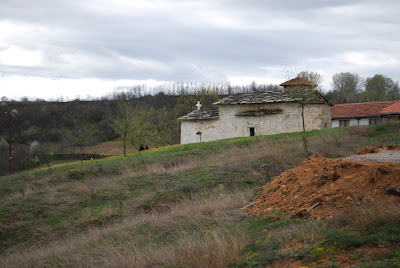We stopped en route to Prizren at Dečani monastery (map), another important Serbian Orthodox monastery, which was built between 1327 and 1335 by the Serbian king St. Stephen. Again, no photographing inside, but the frescoes are worth a visit.
Dečani
The monk on duty in the gift shop was also very affable, and recommended a visit to a ninth-century church in Velika Hoča (map), a small village slightly off the route to Prizren, - though he spoke of the villagers as being hostages in their enclave, under continuous guard from KFOR, and so was not sure how easy it would be.
St John's, Velika Hoča
Nevertheless, off we went, to what was perhaps the most moving part of our time in Kosovo. Until then, Kosovo had seemed vaguely... 'normal', - or, at least, more 'westernised' than is the norm in this region. To begin with, all was fine: we decided to get a taxi rather than wait an hour for the first of several busses we should have had to take, and found one without any difficulty, the (Albanian) driver not blinking when we said where we wanted to go. When we stopped for directions, however, it became clear he had thought we were heading for a larger Albanian settlement nearby, not serbski Hoča, and he became quite... panic-stricken? He tried to dissuade us, speaking of the long distance we would have to walk after the KFOR blockade into the town, and explaining that he could not enter the village. We obviously did not insist that he go, and the (Albanian) local who was giving us directions offered to take us instead, - which he did, without any hesitation or difficulty, chatting affably with the locals when we arrived. Perhaps the presence of mad clear foreigners created a bond, - and any outside impression can only be partial and/or naive, - but it did seem as though there was at least a certain understanding on the local level, - particularly among the younger members of the community. Which is reassuring to this woolly, wet liberal, though I can still picture the face of the taxi driver, and it was sad (though not surprising) to encounter a continued broader distrust.
War Memorial
The village itself? The church was wonderful (no photographing again), but it was depressingly empty. Whether it was more dead as a community than other local small villages, though, or even small communities in Britain or America, is difficult to gauge, but it was slightly surprising to receive change in Serb dinars, - the shop did not have enough change in Euroes even for a five euro note (we made sure to spend them before we left). The procession we witnessed, though, rather sums up the village.
Procession
NB We saw no evidence of KFOR presence there either on the very worn road in, - unlike at Gračanica, Peja, and Dečani, - or in the town itself. Perhaps just chance. Finally, to leave: we asked a local bar owner to drive us to Prizren, - which he did, again without any hesitation, in his Serb-plated car.
Lost?






No comments:
Post a Comment